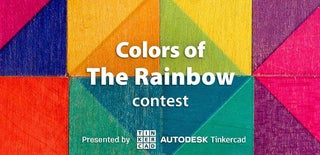Introduction: Multi-layered Design Light Box
This is a multi-layered shadowbox, or rather a light box. Each layer of the painting/design is placed on a separate sheet of plastic and the complete image can only be seen from one angle - only when you look directly at the painting in a straight line. Any small deviations and the image becomes a mass of random shapes.
As this project is for the rainbow contest I used all 6 rainbow colours (and different shades to create variety), but it's entirely possible to create a less colourful, less complex project using just one or two colours. You don't even necessary need a vinyl cutter, you can create random shapes with scissors, just channel your inner Matisse.
This project doesn't work without the light. If it's not lit up, you can't really see the end result, as the frame is too deep. LEDs have to be used
Supplies
The most difficult part of this project was finding a suitable, multi-layered image.
Other than that you will need a vinyl cutter like Cricut or sharp scissors and a lot of patience.
Vinyl sheets in multiple colours.
Acetate sheets (thin, 240 micron laminating sheets).
Picture frame 20x20 or 25x25cm.
You will have to make an extension to the picture frame to create a deep shadow box. You can do it by 3D printing it, making it out of wood, melamine or hardboard, thick crafting foam or cardboard.
You will have to make several separator frames, each plastic sheet will have to be glued to the separator, so how many depends on the complexity of your image. I made mine by using 3d printed sticks I had leftover from another project and gluing them to form square frames. They can be made with crafting foam or wooden sticks, as long as they are semi-sturdy, fit the picture frame and are at least 6mm thick.
Hot glue and plastic glue like poly cement.
Long 12V LED strip, soldering iron and AC/DC converter.
Step 1: EXTENTION AND SEPARATORS
I used thick cardboard to create a picture frame extension. It's about 9cm deep and fits perfectly tight into the frame.
Then, I made plastic sheet separators by gluing long sticks together, they need to fit within the extension's interior. Everything was painted black.
The depth of the frame extension and the amount of plastic separators depends on the complexity of your image. My image has 6 layers, therefore I used 7 separators, 6 for the image layers and one additional for the light diffuser.
Since each separator was 1cm thick I needed my extension to be 7cm. And I added 2cm empty space for the LED strips, so altogether is ended up being 9cm deep.
Step 2: APERTURE
I made a white paper frame that fits within the box and is slightly bigger than the separators. It will help hide any imperfections.
Step 3: CRICUT AND DESIGN
The most tedious part of this project is finding or creating the design.
You need a design with multiple layers, then you need to separate those layers into individual pieces, convert each and every one of them to SVG. Then you have to import it to Cricut and decide which colours to use for each piece of the image before you can finally cut them out.
I used A4 acetate sheets, I cut them into 21cmx21cm squares, which meant I could only make my image 20cmx20cm big (0.5cm free space on all sides reserved for glue).
Step 4: VINYL DESIGN
I used a combination of tweezers and transparent vinyl to transfer each piece of vinyl onto the acetate sheets.
I started by taping the printed image onto a board (I kept the 2nd printed image nearby to help me with placements).
Then, I placed a 21x21cm sheet of acetate in the appropriate place and taped that to the paper.
Starting from the bottom of the image I transferred green vines and stalks onto the first plastic sheet.
Then I placed another plastic sheet on top of the first one and applied the second layer-the larger flower outlines.
Then another layer of plastic sheet went on and another layer of vinyl. And so on and so on, until the entire image was transferred. I removed the masking tape and separated the sheets.
Step 5: SEPARATORS
I used a tiny squeezable bottle with a very small, needle-like opening to apply plastic cement to the separators and glued each plastic sheet to a separate frame. I stacked them together while gluing to make sure they were placed correctly.
Step 6: ASSEMBLY
Once I was satisfied with the result I dropped the separators inside the frame in a correct position.
I added one more separator on top, this one was covered completely in white, semi-transparent vinyl (white piece of paper would work too).
I added LED strips to the back of the frame and glued it together before adding wall fittings.
Note that this picture will be displayed at a 45° angle, so wall fittings have to be placed appropriately.

Participated in the
Colors of the Rainbow Contest













